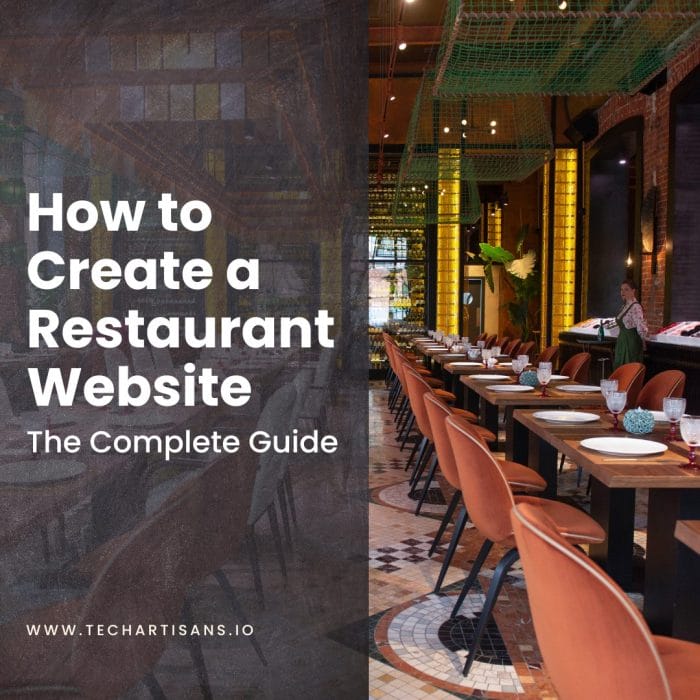In today’s digitized era, the importance of building a restaurant website must be addressed. A restaurant website isn’t just about the menu; it’s an essential part of your brand, offering customers a preview of your unique experience before they visit. It extends your hospitality online, enriching the dining journey for your customers. In this blog, I have put together several tips for creating a restaurant website that reflects your culinary brand.
Why Do You Need a Restaurant Website?
A restaurant website acts as the digital storefront of your culinary business, offering a sneak peek into your brand, menu, and unique dining experience. Here are several reasons why you should get your restaurant website.
1. Showcasing Unique Cuisine
A captivating restaurant website is a virtual stage that highlights your unique culinary offerings. Learn more about the importance of website navigation in engaging visitors to enhance user experience. You can use high-quality images of your dishes, accompanied by tantalizing descriptions, to entice visitors and give them a sense of what to expect.
2. Benefits of Online Table Reservations
Integrating online table reservation features on your restaurant website provides convenience to customers, promoting a seamless dining experience. It allows for efficient table management, reduces potential wait times, and offers insights into customer dining preferences.
3. Reaching More Customers
In the digital age, having a restaurant website opens up opportunities to reach a broader audience. To start effectively, explore where to start with digital marketing for more strategies. Your restaurant becomes accessible to anyone browsing the internet, breaking barriers of location and time.
4. Online Ordering
Online ordering capabilities on your website can increase business by catering to the needs of customers who prefer takeaways and delivery. To streamline the online ordering process, improve customer experience, consider learning about website navigation best practices for 2023.
5. Customer Reviews
A website provides a platform for customer reviews, which can boost credibility. Enhance this feature by understanding how to start a conversation online with your customers. This user-generated content can boost your restaurant’s credibility and influence other potential customers.
6. More Advantages
Beyond these, a restaurant website also provides a platform for promotional activities, seamlessly sharing updates, events, or special deals with your audience. It gives your business a professional image and serves as an effective communication channel with your customers.
Best CMSs to Create a Restaurant Website
Creating a restaurant website may seem complex, but it can be a manageable and rewarding project with the right approach and guidance. Selecting the right Content Management System (CMS) is critical. Learn more about the HTML navigation bar to improve site usability. Here are some popular platforms you can consider:
1. WordPress
WordPress is a highly versatile and customizable CMS, perfect for those who seek full control over their website’s design and functions. It offers multiple restaurant-specific themes, plugins and supports integrations with reservation and delivery platforms. While it may require a learning curve, its flexibility and scalability make it a preferred choice for many.
2. Wix
Wix is a user-friendly platform that allows you to build visually appealing restaurant websites without coding knowledge. It offers restaurant-specific templates, an easy-to-use drag-and-drop builder, and features like online ordering and reservations.
3. Squarespace
Squarespace is a great choice if design is a top priority because it is known for its aesthetically pleasing templates. It offers built-in features suitable for restaurants, like online ordering, menu displays, and reservations.
4. Shopify
If your restaurant plans to significantly emphasize online orders and deliveries, Shopify could be an excellent choice. It’s an e-commerce-focused platform that offers robust features for online selling and integrates with various delivery platforms.
Designing Your Website
When designing your restaurant website, consider exploring the latest web design trends for 2023 for inspiration, you have two options: a ready-made template or a custom design. It’s up to you what you choose.
1. Template Design
This is the most cost-effective and quickest solution. Many CMS platforms offer a range of stylish, restaurant-specific templates that you can tailor to your needs.
2. Custom Design
Consider custom design if you want a unique, tailored appearance and a larger budget. You will likely need to hire a web designer, but the result will be a website that reflects your restaurant’s brand and sets you apart from the competition.
3. Responsive Design
A responsive design adjusts to fit the device it’s being viewed on – whether that’s a desktop, tablet, or smartphone. With more people browsing the web on mobile devices, having a responsive design is vital to provide a seamless user experience.
Essential Pages for Your Restaurant Website
You must have certain key pages to build a restaurant website that effectively serves your customers and your business.
1. Homepage
Your restaurant’s homepage is the digital front door to your business. Enhance its effectiveness with our guide on website navigation best practices for 2023 and often creates the all-important first impression.
It should captivate your visitors immediately with a visually compelling design, engaging them to explore further. Include high-quality images of your food or dining environment to stir appetite and desire. Prominently display your restaurant’s name, location, and contact information to make it easy for potential customers to find you.
2. Table Reservation Page
The table reservation page is an integral part of your restaurant website that simplifies the booking process for your customers. With a user-friendly online reservation system, your customers can easily book a table at their preferred time and date and, if possible, even select their preferred seating area. This eliminates the need for time-consuming phone reservations, providing immediate confirmation of their booking.
3. Menu Page
The “Menu Page” is your restaurant site’s focal point, displaying your culinary delights. It should engage site visitors by making your dishes seem tangible. Organize your menu into clear sections like starters, main courses, desserts, and drinks. Consistent transparency aids customer decision-making and builds trust. Keep the page updated, especially if your menu varies or you offer specials.
4. Contact Us Page
The “Contact Us” page is a vital gateway for establishing a direct line of communication between your restaurant and your customers. It should list the restaurant’s address, phone, and email. If there are multiple branches, consider a location finder or separate contact details for each. You might also include a simple contact form, giving customers an easy way to send you a message directly from the website.
5. About Us Page
The “About Us” page lets you personalize your restaurant and draw your visitors in with your unique story. Start with a brief history of your restaurant, highlighting the inspiration behind its inception and the journey so far. Describe your culinary philosophy and the unique aspects of your menu. Use this space to introduce your team, putting faces to the names that make the magic happen in the kitchen. This helps to humanize your restaurant, fostering a deeper connection with your audience.
Adding Relevant Content to Your Restaurant Website
Adding relevant content to your website is crucial to inform visitors and provide them with the necessary details. Here’s what to include:
1. Menu
The menu is the heart of your restaurant website. Use high-quality images and appetizing descriptions of each dish. Include prices to give customers a clear idea of what to expect. Keeping your online menu up-to-date is essential.
2. About Us
This section should tell your restaurant’s story. It’s a chance to share your unique selling proposition, mission, and the people behind the business. This can create a personal connection with your customers.
3. Contact Details
Make it easy for customers to reach you. Include your restaurant’s physical address, phone number, and email address. You could also add a Google Map widget for easy location tracking.
4. Reservation System
A reservation system or form on your website can streamline the booking process. This convenience can enhance the user experience.
5. Online Ordering
An online ordering system can significantly boost your takeaway and delivery services. Ensure the process is easy to navigate for users.
6. Customer Reviews
Highlight testimonials or customer reviews to build social proof and credibility.
7. Blog
A blog can offer news, updates, or interesting information about your restaurant or food. This can help with the SEO of your website as well as keep customers engaged.
8. Social Media Links
Link your website to your social media pages to boost your online presence. Encourage customers to follow you for updates and promotions to improve your visibility.
9. Newsletter Sign-Up
A newsletter sign-up can help you build your email list and offer a way to communicate directly with your customers.
Enhancing Your Restaurant Website
Enhancing your restaurant website involves optimizing user experience. For comprehensive insights, refer to our article on how to research keywords: a step-by-step guide, improving website aesthetics, and implementing advanced features.
1. Responsive Design
In the era of smartphones and tablets, having a responsive, mobile-friendly design for your restaurant website is no longer a luxury; it’s a necessity. More people are using their mobile devices to search for restaurants and make online reservations. Thus, a website that adapts seamlessly to different screen sizes ensures a smooth browsing experience for all users. Moreover, Google prioritizes mobile-friendly websites in its search rankings, which can significantly influence your online visibility.
2. Effective CTAs
Effective CTAs (Call to Action buttons) are crucial for driving customer actions on your restaurant website. These are buttons or links that guide your visitors toward your desired outcome, such as “Book a table,” “View Menu,” or “Contact Us.”
A well-placed CTA can effectively lead your site visitors down a predefined path toward making a reservation, placing an order, or signing up for a newsletter. Your CTAs should be visually striking, easy to find, and use clear, action-oriented language.
3. High-Quality Images
High-quality images are pivotal in creating an engaging and mouth-watering restaurant website. Food is not only about taste but also about visual appeal. Captivating food photography can entice potential customers, giving them a taste of what awaits them at your establishment.
Invest in professional food photography to capture your dishes in their best light. Every detail matters, from the sizzle of a steak to the vibrant colors of a fresh salad. These images should be strategically placed throughout your website, particularly on the menu page.
4. Social Media Integration
Integrating your social media handles, such as Instagram, Facebook, or Twitter, into your website creates a seamless network between your online presence platforms. This allows visitors to easily interact with your posts and share your content, broadening your reach to potential customers.
Regular updates on social media about new dishes, specials, or events can also keep your audience engaged and informed. Lastly, positive customer interactions on social media can reinforce your restaurant’s reputation.
Registering the Domain Name for Your Restaurant
A catchy and relevant domain name can enhance your brand recognition and credibility. It can also positively impact SEO, making your website more searchable and improving its ranking on search engine results. By incorporating keywords related to your business, such as your restaurant name or the type of cuisine you offer, you can make your domain name a powerful marketing tool in its own right. A domain name that ends in a .com extension is often seen as more professional and trustworthy.
Conclusion
Building a restaurant website and investing time and resources is a strategic business move that can significantly impact your restaurant’s success in the competitive food industry. A restaurant’s website, when finely tuned, acts as a potent marketing tool, ramping up customer engagement and boosting conversion rates. From the small design choices like colors and fonts to important features like online booking and social media links, every aspect works together to create an appealing online presence for your eatery.
FAQs
1. What are the key features of a successful restaurant website?
A successful restaurant website should have an appealing design, user-friendly navigation, a responsive layout, high-quality images, and effective call-to-action buttons. It should also include clear and detailed menu information, social media integration, contact and location details, and an online reservation or ordering system.
2. What technology stack is recommended for building a restaurant website?
The technology stack can vary based on the specific requirements of the website. However, a typical restaurant website may use HTML, CSS, and JavaScript for front-end development, with PHP, Laravel, or Python for the backend. Other technologies like Bootstrap can be utilized for faster and easier web development.
3. How important is mobile optimization for a restaurant website?
Mobile optimization is crucial given the growing number of users accessing websites on mobile devices. A mobile-friendly site ensures a good user experience regardless of the device used, potentially leading to increased customer engagement and conversion rates.
4. How can social media integration benefit my restaurant website?
Social media integration can drive more traffic to your website by broadening your reach to potential customers. It allows visitors to easily share your content, engage with your posts, and help reinforce your restaurant’s reputation.
5. Do I need professional help to create my restaurant website?
While DIY website builders are available, professional help can ensure a high-quality, optimized website tailored to your needs. Professionals can also provide ongoing support and maintenance, which is particularly useful for non-technical restaurant owners.
6. How can I measure the success of my restaurant website?
Website analytics tools can provide valuable insights into user behavior, traffic sources, and conversion rates. Regularly monitoring these metrics can help you assess your website’s success and identify improvement areas.











































